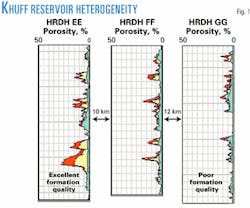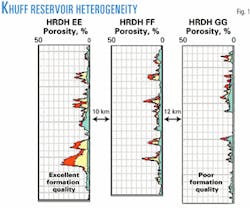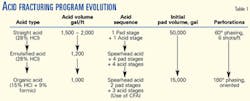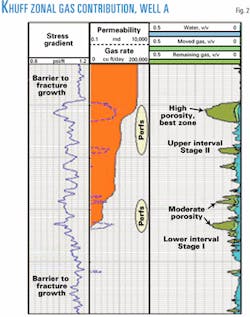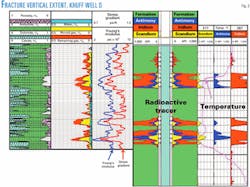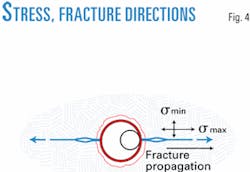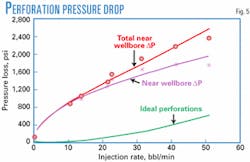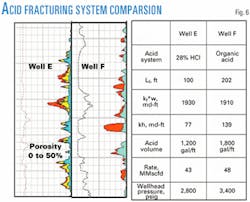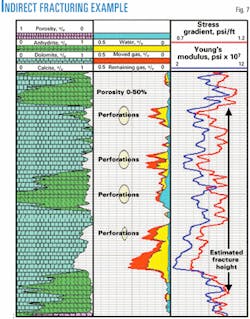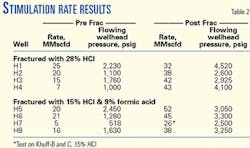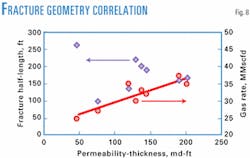Saudi Aramco optimizes acid fracturing in the Khuff carbonate reservoirs
First of a series
Saudi Arabian Oil Co. (Saudi Aramco) has initiated a gas development program that requires acid fracturing wells in the Khuff carbonate reservoir of South Ghawar to deliver 1.2 bcfd of nonassociated gas production.
Since start of the acid fracturing campaign in 1999 the company has performed over 20 stimulations.
This first article in a three-part series on Ghawar field gas well completions highlights Saudi Aramco's efforts to optimize acid fracturing in the Khuff carbonate reservoirs.
As work progressed, engineers realized from the complex nature of the formation that each well required individual analysis and fracturing design.
The in situ stress contrast between zones, permeability variation, and interval thickness differences dictated whether single or multiple fracturing stages were required to achieve the goal of stimulating all net pay intervals.
A change in tubing metallurgy, to the use of corrosion-resistant alloys, drove the need for lowering acid concentrations and changing acid formulations.
The resulting use of 15% hydrochloric acid mixtures has yielded similar results compared with the originally designed straight and emulsified 28% HCl acids.
Oriented perforations have reduced near-wellbore pressure drop during stimulation, making fracture initiation and propagation more efficient.
To optimize future acid fracturing designs, the company performed extensive reservoir characterization, used a coupled reservoir geomechanics model to history-match acid fracturing data, calibrated leak-off, and stress dependant permeability and predicted long-term well performance.1
Also as part of the optimization effort, Saudi Aramco's local research and development center performed numerous sensitivity studies on acid reactions with the Khuff formation carbonate cores.
The company has achieved distinct improvements in applying and optimizing stimulation technology.
The research and development effort continues for optimizing treatments in terms of cost, to maximize stimulation effectiveness, and to meet future completion requirements.
Engineering effort
The complex nature of the heterogeneous carbonate formation, the high tectonic stresses encountered in the field, and variation of reservoir and fluid properties have made development of the carbonate reservoir challenging.
During the development stages, the company performed numerous pressure-transient analyses before and after fracturing, ran radioactive tracer and temperature logs during minifracture and main-fracture treatments, performed production tests, and ran production logs to evaluate and assess reservoir and fracturing success.
Simultaneously, the company also undertook many research initiatives and studies to better understand the reservoir characteristics and fluid flow behavior.2
As part of the study, engineers developed a reservoir simulation model to match production data, perform sensitivity on fracture characteristics, optimize fracture dimensions, and forecast production performance.
Saudi Aramco performed several microfrac and minifrac tests, routine and special core analysis, and laboratory experiments to calibrate geomechanical and fracture models used to predict reservoir in situ stress properties and fracture characteristics.3
The geomechanical model thus developed by the company predicts the most important mechanical properties such as in situ stress, Young's modulus, and Poisson's ratio with precision, which in turn are used by the fracturing model to compute fracture initiation, propagation, and conductivity.
Khuff reservoir
The Khuff, being a deep gas condensate reservoir under an active tectonic stress environment, consists mainly of dolomite and limestone sections with streaks of shale and anhydrite constituting nonpermeable zones that are possible fracture barriers.
The formation can be up to several hundred feet thick, with varying reservoir quality and production potential.
Fig. 1 illustrates the degree of reservoir variation and heterogeneity from porosity logs, covering about a 50 ft interval in three wells. Each well demonstrates varying reservoir quality from zone to zone and heterogeneity within the same zone from well to well.
Although the three wells are not far from each other, well HRDH-EE shows excellent development in reservoir porosity, particularly in the bottom section where the porosity is as high as 27%.
This contrasts sharply with the same section in well HRDH-GG, which is poorly developed, and with well HRDH-FF, which indicates intermediate reservoir development.
Program evolution
Saudi Aramco has selected to develop the Khuff reservoir with vertical wells and acid fracturing as the completion scenario.
To ensure successful gas reserves depletion, engineers must accurately model geomechanical properties and employ the best acid-fracturing technology.
The acid-fracturing program, as a result, has evolved during the past 2 years with several incremental program changes implemented for efficient Khuff reservoir development.
Engineers have calibrated the existing geomechanical and fracture model, improved the mechanical wellbore completion, adjusted the pumping schedule, and modified the acid formula to optimize on the reservoir properties.
During initial stages of the project, stimulation programs called for large pad volumes and acid sequences for fracturing. The stimulations have since evolved to smaller volumes and more-efficient designs.
Table 1 summarizes the evolving trends in the acid-fracturing program details. Generally, fluid volumes and the number of stages have decreased.
Pad volume
The initial pad fluid volume initiates and propagates a fracture that is wide and long enough to transport acid into the formation easily and quickly.
The pad volume must be large enough to yield a fracture length adequate for a particular formation as well as give the vertical coverage for all pay zones of interest.
Too little pad volume may not create the fracture required for optimal production.
On the other hand, excessive pad volume will not increase etched fracture area, as acid may already have been spent before it reaches all of the fracture that was created. In fact, excessively large pad volumes will damage the formation more than benefit fracturing.
Wells exhibiting moderate to good reservoir quality, where the objective is creating highly conductive fractures, require low pad volumes.
The company treated five early wells with more than 40,000 gal initial pad volume, reducing the volume to 15,000 gal for the next 20 wells.
Most of the later wells have tested at the expected production increase, following acid fracturing treatments.
The change to lower pad volumes has reduced acid fracturing costs without compromising treatment effectiveness.
Staged fracturing
Saudi Aramco has performed multiple independent fracture treatments in the same wells but in different zones, based on extensive sensitivity runs with the fracture design model.
The in situ stress contrast between productive and nonproductive reservoir intervals, layer flow properties, and the layer thicknesses impact this staging.
The use of correct geomechanical and reservoir properties-then making sensitivity runs on fluid volume, perforation placement, and other job parameters-should indicate whether or not a single treatment will contact and effectively cover all vertical net pay intervals.
Fig. 2 shows the example of Well A, with upper and lower productive intervals contributing most of the production rate, as indicated by the flowmeter survey in the middle.
A 50-60 ft thick interval, partially porous and permeable, separates the distinctive higher quality upper and lower reservoir sections. The stress gradient curve on the left shows that the in situ stress contrast between the better and poorer quality reservoir rock is about 0.1 psi/ft (Fig. 2).
The fracture model design runs indicated that the upper and lower reservoir sections could not be effectively treated with single-stage acid-fracture stimulation.
A single-stage stimulation job would not propagate a fracture through the stress barrier.
Because both sections had good net pay sections, as indicated by the production profile log, the company decided to implement two treatments separately in the upper and lower sections.
Each interval and treatment called for about 30,000 gal of 28% HCl, with a slightly larger pad volume required for the second stage (upper interval) to yield sufficient width and penetration.
The well tested at 10 MMscfd and 2,500 psi flowing wellhead pressure for the lower intervals, compared with 42 MMscfd at 3,400 psi flowing wellhead pressure for the entire well with all intervals producing at the end of a 3-day production test.
Well C, with reservoir properties similar to those of Well A and treated with a two-stage acid-fracturing job, tested similarly at about 42 MMscfd at 3,000 psi flowing wellhead pressure after 7 days of production testing. Each stage consisted of 32,000 gal of 28% HCl acid.
Saudi Aramco performed the acid-fracturing stimulation on Well B in a single stage of 65,000 gal of 28% HCl. The single-stage treatment effectively fractured all production intervals, yielding a post-stimulation rate of 38 MMscfd at 2,700 psi at the end of a 3-day production test.
Although the production tests were short, the gas rates and wellhead pressures indicated excellent performance from all three wells.
Fig. 3 presents another example, Well D, with acid-fracturing stimulation pumped in a single-stage treatment.
Although characterized by three distinct and very prolific reservoir intervals, formation properties were similar, and preliminary acid-fracturing design sensitivity runs indicated that a single treatment would effectively contact all three sections.
The job design called for pumping radioactive tracers of three different isotopes during the pad and acid treatment. The log survey following the treatment showed effective invasion of pad and acid in all intervals, assuring creation of conductive fracture in all net pay intervals (Fig. 3).
Perforations
Stimulation fluids gain access to the formation through the perforations, to initiate and propagate fractures, which inherently become critical to stimulation treatment success.4
If the perforations are large and correctly oriented, in the direction of maximum in situ horizontal stress, then the configuration significantly reduces friction pressure and the overall injection pressure during fracturing.
Engineers have determined maximum horizontal stress, in the Khuff reservoir of South Ghawar field, to be very close to the east-west direction.
South Ghawar Khuff well completions should, therefore, call for oriented perforations shot in the east-west direction at 180° phasing, thus being aligned within a single vertical plane.
Wells completed in this manner, ensuring all perforations are in the direction of maximum horizontal stress, will direct the fracturing fluids to propagate the fracture immediately after initiation.
Fig. 4 illustrates in situ stress and fracture development in the Khuff reservoir. The company has just recently begun using the oriented perforations in the Khuff gas reservoir.
Preliminary analyses indicate significant reductions in near-wellbore friction pressure that would otherwise be present due to the tortuous path that fracture fluid must take before proceeding toward the maximum stress direction to initiate and propagate the fracture.
Fig. 5 shows injection and rate data plotted from an example well step-rate test that was conducted prior to fracturing to measure near-wellbore pressure drop.
The graph shows that a wellbore would experience over 2,000 psi of excess pressure or friction pressure for a typical 40 bbl/min injection rate. Wellbore tortuosity effects from inefficient perforation orientation would generate for most of this pressure drop.
A recent Khuff well, completed with oriented perforations, experienced total near-wellbore friction pressure loss of only a few hundred psi, significantly less than prior wells perforated with 60° phasing.
Engineers believe the significant difference was due to the easy and direct path toward maximum stress direction, along which the fracture propagated.
Acid formulations
Saudi Aramco has experimented with different acid formulas in its acid-fracturing program. A recent change in tubular metallurgy, the desire to achieve increased fracture half-length in lower permeability reservoirs, and the need to reduce stimulation costs had driven the issue.
Until recently, the company has used 28% gelled HCl in all acid fracturing treatments, along with large acid volumes, on the order of 1,800 gal/ft of net interval to be stimulated.
To achieve increased fracture half-lengths, the company has used emulsified acid in conjunction with the 28% gelled acid.
Emulsified acid has been proven to spend more gradually than straight acid, thus increasing etched fracture length.
The need to reduce acid strength has become very important, as new wells are being completed with 13-chrome tubing, rather than regular carbon steel, to address the gas corrosion issues.
While regular carbon steel can tolerate the 28% HCl acid concentrations, the formulation is highly corrosive to the 13-chrome metallurgy, prohibiting its use in acid fracturing.
The company has recently fractured a few wells with an organic acid formulation of 15% HCl and 9% formic acid. The wells have tested at substantially higher gas production rates after fracturing, attesting to the new acid system's effectiveness.
Saudi Aramco has also adjusted the amount of acid used in fracturing, based on lower acid volumes per foot of net pay.
The company has recently used 1,000-1,200 gal/ft for 28% HCl acid treatments, but with the 15% HCl organic acid system still maintains high volumes per foot to ensure fracture face etching effectiveness.
The company continues to study the use of organic acid systems in the Khuff, attempting to optimize on appropriate acid volumes required.
Fig. 6, showing the porosity profiles of two Khuff wells, offers a comparison of two acidizing systems. Well F exhibits better reservoir quality, compared with Well E in terms of porosity and flow capacity.
Crews had performed an acid-fracturing treatment in Well E with 28% HCl gelled acid in October 2000 and in Well B in March 2001 with 15% HCl and 9% formic acid.
The table in Fig. 6 presents post-fracture rate, pressure, and other reservoir and formation parameters for comparison.
The post-fracture data indicate that both wells had been stimulated almost equally. Even though the Well-F permeability-thickness product is double that of Well E, it produces at only a 5% higher gas rate and 20% higher flowing wellhead pressure.
Accordingly, the reduction in acid concentration had little negative impact on productivity. On the contrary, engineers expected the lower acid concentration to have more lateral penetration.
Indirect fracturing
The company has employed an indirect fracturing technique in the Khuff carbonate reservoir, which is to perforate away from the best-quality reservoir zones and perform acid-fracture stimulations from the lower-quality formation intervals (Fig. 7).
The concept expects that fractures will grow vertically, contacting and effectively etching the better-quality intervals, after traversing the lower-quality reservoir intervals from which they were initiated.
Because of reservoir heterogeneity, differing layers may have largely contrasting porosity and permeability values.
As such, acid penetrates preferentially into the most porous and permeable sections if the entire reservoir is perforated and fractured simultaneously.
Fig. 7 shows the example well where the lowermost Khuff-C interval is the most prolific.
Fracture sensitivity runs indicated that if the lowest interval were perforated, most of the acid would have penetrated and been spent in the interval, leaving the upper porous sections with less-effective treatments.
During subsequent completion and stimulation, the company avoided perforating the lowermost interval.
Fracture diagnostics indicated that the fracture quickly penetrated the lower section, however, effectively etching all net intervals.
The well attained an excellent etched fracture throughout the entire pay section.
Long-term testing
As part of the optimization process, Saudi Aramco has conducted long-term testing on wells to examine gas production and bottomhole pressure sustainability and the effectiveness of fracture conductivity.
A 7-day production test, conducted on a Khuff well after acid-fracture treatment, showed that although there had been about 500 psi pressure drop during the test period, the rate has been fairly steady.
History matching of rate and pressure data and forecasting to 10 years showed that about 70 bcf of gas could be produced from this reservoir, which is about 30% more than the production that could be achieved from a nonfractured reservoir.
Rate improvement
Acid fracturing has clearly improved gas production rates in wells completed in the Khuff carbonates.5
Table 2 summarizes the results obtained. The company fractured Wells H1-H4 with 28% HCl acid and Wells H5-H8 with 15% HCl and 9% formic acid mixture.
Pre and postfracture production tests from the wells indicated about a twofold increase in short-term gas production rate. Flowing bottomhole pressure increased significantly as well (Table 2).
The Khuff formation has responded favorably to acid fracturing with use of the organic acid in comparison to the stronger 28% HCl acid.
Fig. 8 shows fracture half-length and postfracture production rate as function of permeability-thickness product (kh). Interestingly, the plot shows that as kh values increase, the calculated fracture half-lengths become shorter.
Fluid leakoff and the acid being spent close to the wellbore explain this phenomenon. For better reservoirs, where porosity and permeability are higher, much of the acid cannot penetrate far before it is spent in the formation.
The initial stimulation design process takes this into account, where the focus is to achieve short and highly conductive fractures, for the moderate to high-permeability reservoirs.
Geomechanical model
As part of the acid-fracturing optimization efforts, the company initiated a detailed coupled geomechanics modeling study to optimize several aspects of well performance during and after acid fracturing.6-8
The study objectives were to model microfracture and fracturing treatments, in situ stress changes during depletion, stress changes during fracture injection, estimate possible near-wellbore restriction effects on injection pressure, and finally, predict postfracture production performance.
Saudi Aramco began the work by modeling injection tests in two wells, HWYH-AA and HRDH-AA, using a coupled reservoir and geomechanical approach, in combination with dynamic fracture modeling.
In addition, the company modeled the acid treatment in HWYH-AA with use of a fracture model and predicted the acidized fracture dimensions.
Using the results of this work, engineers built a sector (single well) model of a typical well and generated an acid fracture treatment for the well with use of acid data calibrated by the match of the well HWYH-AA.
Once this model had been generated, engineers used it to study the geomechanical effects on long-term production.
Modeling methodology
Briefly reviewing the coupled reservoir flow and geomechanical model, the primary coupled phenomena occurring in the reservoirs are:
- Stress changes induced by pressure changes (poroelasticity).
- Stress changes induced by temperature changes (thermoelasticity).
- Multiphase fluid flow dependence on stress through the pore volume coupling.
- Permeability and relative permeability dependence on stress.
- Fluid flow properties dependence on temperature (thermal reservoir simulation).
- Initiation and propagation of induced fractures.
- Dependence of flow conductivity of propped or acidized fractures on stress.
These phenomena can be thought of as couplings between three main simulation modules: a thermal reservoir simulator, a stress-strain simulator (including poro- and thermoelasticity), and a fracture mechanics simulator.
Model results
The predicted fracture dimensions have proven very sensitive to reservoir and rock mechanical properties. indicating large potential for optimization, the need for careful design, and analysis and consideration of uncertainties.
Stress-dependent properties in depleted reservoir regions can have a large impact on well deliverability. Ignoring the effect will overpredict the production, while modeling it with a conventional reservoir simulator with k = f(p) will underpredict it.
For a fractured well, the stress dependence of fracture conductivity (Cf) is the dominant factor.
References
- Saudi Aramco gas reservoir management division internal documents and research and development center internal research reports.
- Al-Qahtani, M.Y. and Rahim, Z., "A Mathematical Algorithm for Modeling Geomechanical Rock Properties of the Khuff and Pre-Khuff Reservoirs in the Ghawar Field," SPE 68194, presented at the Middle East Oil Show, Bahrain, March 2001.
- MECPRO, a Geomechanical Calibrated Model to compute In Situ Rock Properties, Saudi Aramco.
- Rahim, Z. and Al-Qahtani, M.Y., "Selecting Perforation Intervals and Stimulation Technique in the Khuff Reservoir for Improved and Economic Gas Recovery," SPE 68216, presented at the Middle East Oil Show, Bahrain, March 2001.
- Rahim, Z., Al-Qahtani, M.Y., and Buhidma, I., "Improved Gas Recovery From Acid or Hydraulic Fracturing," Saudi Aramco Journal of Technology, Spring 2000.
- Report on Geomechanical Modeling, Saudi Aramco internal document.
- Settari, A. and Mourits, F.M., "A Coupled Reservoir Geomechanical Simulation System," SPEJ, September 1998, pp 219-226.
- Settari, A. and Walters, D.A., "Advances in Coupled Geomechanics and Reservoir Modeling With Application to Reservoir Compaction," SPE 51927, presented at the 1999 SPE Reservoir Simulation Symposium, Houston, Feb. 14-17, 1999.
The authors
Mohammed Y. Al-Qahtani is supervisor of Saudi Aramco's gas reservoir management division special studies unit. He is a reservoir engineering expert specializing in geostatistical modeling, reservoir characterization, reservoir simulation, and phase behavior. He has developed a geomechanical model to predict reservoir rock properties in the Ghawar gas fields. He received his PhD in petroleum engineering from the University of Southern California in 1996 and is a member of SPE.
Zillur Rahim works for Saudi Aramco's reservoir management department specializing in well stimulation and reservoir engineering. He is a mentor for the technologist development program, which is dedicated to the training of young Saudi engineers. Prior to joining Saudi Aramco, he worked with Hol ditch & Associates Inc., and later with Schlumberger Holditch-Reservoir Technologies in Texas. He received an MS and PhD in petroleum engineering from Texas A&M University. He is a technical editor for SPE and a registered professional engineer in Texas.
